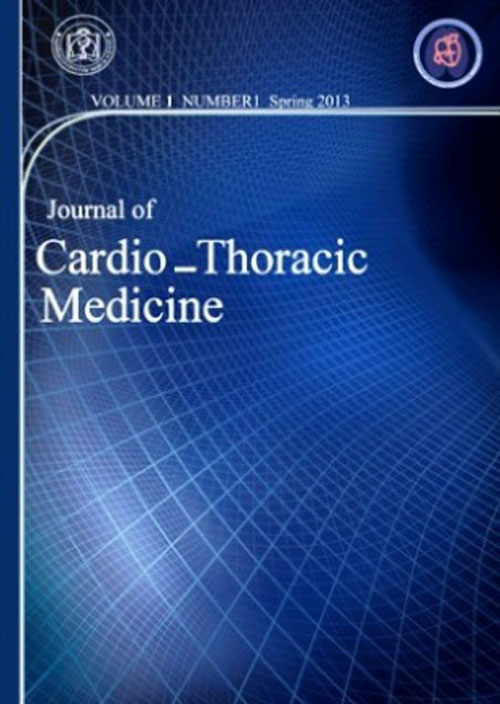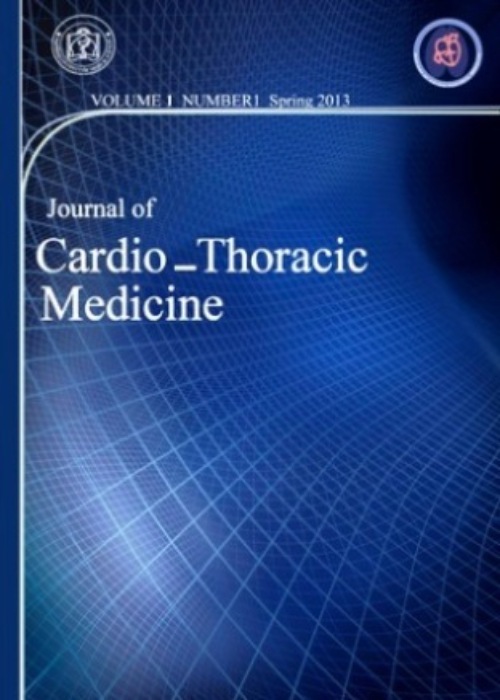فهرست مطالب

Journal of Cardio -Thoracic Medicine
Volume:9 Issue: 2, Spring 2021
- تاریخ انتشار: 1400/04/13
- تعداد عناوین: 8
-
-
Pages 780-785
Physical activity (PA) and obesity are effective interventions for hypertension. The current study is a review to explain possible mechanisms related to the effects of PA and obesity on hypertension. To this end, several scientific databases were searched using the keyword "hypertension" and also some English articles related to obesity and PA were investigated. Then, the mechanisms of obesity and PA associated with hypertension were extracted from the collected articles. Overall, obesity causes an increase in renin-angiotensin-aldosterone (RAA) systems, harmful changes in lipid and lipoprotein profile, a decrease in insulin sensitivity, as well as harmful changes in adipokines, oxidative stress, and inflammatory factors. PA improves the above-mentioned changes caused by obesity. Overall, PA mainly via an effect on oxidative stress, inflammation, endothelial cells, the elasticity of arteries, body weight, the activity of the RAA system, activity of parasympathetic and renal function as well as improve the insulin sensitivity has positive effects on hypertension. It should be noted that the effects of PA against hypertension is highly variable and they are related to PA modes, environmental and genetic factors.
Keywords: Adipokines, Insulin sensitivity, lipid, lipoprotein profile, Oxidative Stress Renin-Angiotensin-Aldosterone Systems -
Pages 786-797IntroductionChronic obstructive pulmonary disease (COPD) is a common medical problem. The improper implementation of inhaler techniques thatare used in such patients leads to the reduced effect of medicines. This study was conducted to evaluate the correct use of various inhalers among COPD patients.Materials and MethodsThis observational, cross-sectional study was carried out on 96 patients with COPD aged over 40 years. The samples were selected using asystematic random samplingmethod from patients with COPD referring to the clinics of Ghaem and Imam Reza hospitals, Mashhad, Iran, from March 2018 to March 2019. The subjects were informed that their participation in the study was voluntary. These cases were under the treatment of using at least one inhaled medicine for a month or more. The adopted technique of applying four types of inhalers was evaluated by a standard checklist. The patients' performance scores of all procedures were recorded, and the collected data were analyzed in SPSS software (version 16).ResultsOur study revealed that more than 98% of patients used metered-dose inhaler (MDI) spray (P=0.05). The patients' scores on the correct use of MDI, Diskus, Turbuhaler, and HandiHaler inhalers were estimated at 68, 77, 87, and 90%, respectively. The most common mistakes in using MDI and HandiHaler inhalers were related to the 'holding the breath' and "taking a deep inhale' steps after using the inhaler, respectively.ConclusionPhysicians must evaluate and modify the use of inhalers in every COPD patient. It is recommended that easy-to-use inhalers, such as HandiHaler, be prescribed for such patients.Keywords: Chronic Obstructive, Pulmonary Disease, Inhalation devices, Technique
-
Pages 798-804IntroductionAtrial myxomas are rare benign tumors; causing obstructive or embolic complications, or even death, depending on their site and size. Therefore, once diagnosed, it should be surgically resected. Atrial myxomas are present about 75% in left atrium (LA) and about 15% in right atrium (RA). Early diagnosis is a challenge because of nonspecific manifestations, and sometimes is asymptomatic and may be discovered accidentally during transthoracic echography (TTE).Minimally invasive cardiac surgery (MICS) has benefits over sternotomy include cosmetically, less pain, and shorter total hospital stay.Materials and MethodsBetween January 2011 to December 2020, (50) patients [30 Sternotomy, 20 MICS] underwent surgery for isolated resection of cardiac myxoma. We reported outcomes; cardiopulmonary bypass (CPB) time, aortic cross-clamp (ACC) time, conversion to median sternotomy (ST), total hospital stay, complications (stroke, renal failure, respiratory failure, reoperation, and infection), pain, patient¢s satisfaction, recurrence and survival. Follow-up time was from 6-months to 3-years.ResultsThere is no significant difference in CPB or cross-clamp time between groups. No minimal invasive (MI) cases required conversion to a median ST. Total hospital stay is shorter in the MI group by 2.2 days (p-value = 0.045). No differences present in morbidity or mortality between two groups.ConclusionsSurgical resection of atrial myxoma resection by minimal invasive approach is safe, feasible, and favored over sternotomyKeywords: myxoma, Median Sternotomy, Minimal Invasive Cardiac Surgery, Right Anterolateral Mini-Thoracotomy
-
Pages 805-809IntroductionThis study aims to compare the clinical outcomes of patients treated with Cre8TM versus Resolute Onyx™ stent.Material and MethodsIn this retrospective study, all patients who underwent Stenting in the catheterization department of ShahidMadani Hospital between 2015 and 2018, were included. Angiographic and angioplasty findings were recorded. The primary end point, which includes total mortality, myocardial infarction, revascularization (adverse events) were recorded.ResultsThe mortality rates were similar in both groups. Moreover the myocardial infarction and repeated revascularization did not differ in both groups (p>0.05).The rates of adverse events wasn't significantly different between the two groups.ConclusionOur study showed that efficacy and safety of Cre8™ stents is non-inferior to the Resolute Onyx™ stent.Keywords: Coronary Artery Disease, Drug eluting stents, Amphilimus-eluting stent
-
Pages 810-816
Introdution:
Postoperative bleeding, pericardial effusion and arrhythmia (especially atrial fibrillation) are among the most common and important postoperative complications of CABG. Postoperative pericardial effusion can cause tamponade and also increases the incidence of atrial fibrillation. Posterior pericardiotomy is performed to reduce the incidence of pericardial effusion and its complications. This study aimed to investigating the results of posterior pericardiotomy in coronary artery bypass grafting surgery.
Material and MethodsIn this descriptive / cross-sectional study, 145 patients undergoing coronary artery bypass grafting at Farshchian Heart center from March 2019 until March 2020 were selected by convenience and consecutive sampling method and examined for early results of posterior pericardiotomy. Data were analyzed using SPSS software version 16 at 95% confidence level.
ResultsThe mean age of patients was 63.96 years, 75.2% were male and 24.8% were female. 91% of operations were elective and 55.9% were on pump CABG .The incidence of postoperative Atrial fibrillation was 9.66%, pericardial effusion was seen in 3.36%patients, which was mild in 2.67% and moderate in.69%cases.Tamponade was not seen in any case .The overall mean drainage of all chest drains from the beginning to the time of drain removal, was about 795±409 cc.
ConclusionPosterior pericardiotomy is a simple and safe method of draining posterior pericardial space that may be effective in reducing the incidence of atrial fibrillation, pericardial effusion and pleural effusion after coronary artery bypass grafting
Keywords: Posterior Pericardiotomy, Coronary artery, Bypass GraftingTamponade -
Pages 817-823IntroductionPleural effusion is an accumulation of fluid in the pleural space. It can be transudative or exudative. Mechanisms like alteration in Starling’s forces lead to transudative effusions while inflammation and infiltration by infections, malignancy, connective tissue diseases, etc lead to exudative effusions. Tuberculosis, viral, bacterial infections, and malignancy are common causes of exudative effusions whereas congestive heart failure, renal failure, and liver failure, etc are common causes of transudative effusions. Nearly 40% of patients with malignancy have pleural effusion at the time of presentation. Bronchogenic carcinoma, carcinoma of the breast, lymphoma are the leading causes of malignant pleural effusion (MPE) followed by gastrointestinal, genitourinary, and gynecological causes. Pleural fluid Adenosine DeAminase (ADA) has good diagnostic sensitivity and specificity for tuberculosis whereas pleural fluid cytology /biopsy are the main diagnostic modalities for MPE. However pleural fluid cytology is positive in only 48.5% of cases in the first sample but the yield increases with repeated analysis or other more invasive investigations like blind pleural biopsy/thoracoscopy. In cases with negative pleural fluid cytology, a biochemical marker known as Cancer ratio i.e serum LDH and pleural fluid ADA can be useful in predicting malignant causes. A cancer ratio cutoff of more than 20 helps in guiding the physician for further workups like FDG PET or tumor markers in evaluating malignancies. With this background our study aimed at the usefulness of cancer ratio in patients with exudative pleural effusion.Materials and MethodsIt's a cross sectional observational study done for a period of 18months.100 adult patients with exudative pleural effusions were recruited into the study. Those who didn’t give consent, hemodynamically unstable, whose diagnosis is known were excluded. Serum LDH, pleural fluid ADA were done in all cases and the cancer ratio is validated for diagnosis of malignant effusions.ResultsThe mean age of patients was 55.48±9.32 years. There were 57 malignant and 43 nonmalignant cases. Bronchogenic carcinoma was the leading cause of MPE and tuberculosis was the commonest cause of non-malignant pleural effusions. Mean serum LDH, Pleural fluid ADA, and cancer ratio in malignant cases and nonmalignant cases was 434.54 and 350.04IU/ml,19.05 and 32.97IU/ml and 25.13, 20.45 respectively. The sensitivity of cancer ratio was 70.17%, specificity was 76.74%, Positive predictive value was 80% and Negative predictive value was 66.6%.ConclusionCancer ratio is an easy and valid diagnostic tool in suspecting malignant pleural effusions with good sensitivity and specificityKeywords: Cancer ratio, Pleural Effusion, Malignancy'Exudates
-
Pages 824-828
Benign metastatic leiomyoma (BML) spreading in the lung is rare entities predominantly in a young woman. To our knowledge, our observation is the first description of benign metastasizing leiomyoma of the lung from Madagascar.We describe a case of 44-year-old of Malagasy origin, asymptomatic, non-smoking woman who had a history of hysterectomy for myoma three years earlier. Chest computed tomography (CT) revealed multiple well defned nodular shadows in the lung. One tumor of the middle lobe was resected by lateral thoracotomy. The resected lesion consisted of benign spindle cells and was diagnosed as BML. Through this clinical case, we present the first case report of a BML patient from Madagascar. The aim of this article is to take stock of the knowledge relating to this rare affection, and to propose management in accordance with the current literature
Keywords: Benign Metastasizing, Léiomyoma, lung metastasis, Leiomyoma Pulmonary, Nodules -
Pages 829-832
We report pulmonary thromboembolism (PTE) as the merely manifestation in a young man with covid 19. He had no any infectious presentation such as fever, headache, bone pain, cough, dyspnea and diarrhea. The Upsetting left pleuritic chest pain was the only compliant. Lung CT angiogram reported thrombus in the left and right pulmonary artery, but no any risk factor for PTE detected was found. According to high prevalence and world epidemic of the Covid 19, PCR was performed and then defined Corona virus 2.
Keywords: Covid 19 Pulmonary, Thromboembolism, Chest Pain CT, Angiogram


